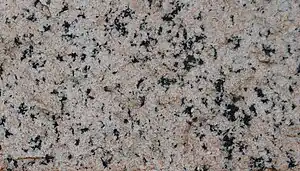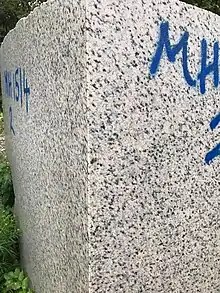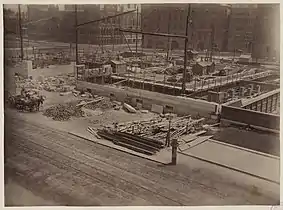Milford pink granite
Milford pink granite, also known as Milford granite or Milford pink is a Proterozoic igneous rock located in and around the town of Milford, Massachusetts, covering an area of approximately 39 square miles (100 km2), as mapped by the USGS. It is also sometimes referred to as Braggville granite, for several quarries in the neighboring village of Braggville, Massachusetts.[2]
| Igneous rock | |
 | |
| Composition | |
|---|---|
| Silicon dioxide, Aluminium oxide, Iron(III) oxide, Manganese(II) oxide, Calcium oxide, Magnesium oxide, Potassium oxide, Sodium oxide, Biotite[1] |
From 1870 to 1940, the town of Milford became famous for the "pink" variety of this stone, prized as a building material. According to local legend, the granite was "discovered" in the early 1870s by two brothers, James and William Sherman at Rocky Woods in Milford.[3] At its peak, over 1,000 men labored in dozens of quarries in Milford and nearby Hopkinton. A sample of Milford Pink is on display at the Smithsonian Institution.[4]
Milford pink granite is quarried by the Fletcher Granite Company, at their Lumber Street quarry in Hopkinton.[5]
Description

The granite is described as a light gray or light pinkish-gray to a medium, slightly pinkish or pinkish and greenish-gray biotite granite with spots from 0.2 to 0.5 inches (5.1 to 12.7 mm) across and in some cases tapering out to 1 inch (25 mm) in length.[1] The biotite is typically in clots or short streaks. It is commonly locally gneissic.[6] The color of the stone is governed mainly by its feldspars, pink from the potash and green from the soda lime feldspar.[1]
Examples of use



- Massachusetts
- Bancroft Memorial Library, Hopedale (1898)
- Boston Public Library, McKim Building, Boston (1895)
- Flour and Grain Exchange Building, Boston (1892)
- Memorial Hall, Milford (1884)
- Town Hall, Hopedale (1886)[7]
- Worcester City Hall, Worcester (1898)[8]
- New York City
- American Museum of Natural History (1869)[9]
- Brooklyn Museum, Brooklyn (1895)[9]
- General Post Office Building (1912)
- Pennsylvania Station (1910)[10]
- University Club of New York (1899)[9]
- Washington, D.C.
- Eccles Federal Reserve Building (1937)[11]
- First Division Monument (1924)[11]
- Zero Milestone (1923)[12]
- Other
- Allegheny County Courthouse, Pittsburgh, Pennsylvania (1888)[13]
- Cullum Hall of The United States Military Academy at West Point, New York (1898)
- John J. Glessner House, Chicago, Illinois (1887)
- Pennsylvania Station, Baltimore, Maryland (1911)
- Singapore Changi Airport, Changi, Singapore (2002)
See also
References
- T. Nelson Dale (1923). "The Commercial Granites of New England" (PDF). United States Geological Survey. Retrieved August 22, 2017.
- "TAWANI Foundation Donates $150,000 for Preservation of Glessner House Museum". Tawani Enterprises, Inc. August 29, 2017.
- Sweetser, Moses Foster (1889). "braggville+granite"&pg=PA205 King's Handbook of Newton, Massachusetts. Moses King Corporation. p. 205.
- Brayley, Arthur Wellington (1913). "braggville+granite"&pg=PA33 History of the Granite Industry of New England. Vol. I. Boston: National Association of Granite Industries of the United States. p. 33.
- Blackstone River Valley Archived 2008-09-07 at the Wayback Machine
- "Did You Know Milford's Pink Granite is in the Smithsonian?". 12 June 2018.
- "Our Granites". www.fletchergranite.com. Archived from the original on 2016-06-03.
- USGS Milford Granite
- Hopedale Town Hall
- Milford Daily News, May 31, 2008
- "Milford Pink Granite". City University of New York. Retrieved June 2, 2017.
- Work on the Future of Pennsylvania Station Unearths a Bit of Its Past, The New York Times, November 8, 1998.
- "Milford Pink granite". Museum of Fine Arts, Boston. Retrieved August 22, 2017.
- "Zero Milestone – City Walking Guide".
- Bragg, Ernest A (1958). History Of Braggville Section of Holliston, Medway and Milford. Boston. p. 13. OCLC 6115177. Retrieved 3 Jul 2015.
{{cite book}}: CS1 maint: location missing publisher (link)